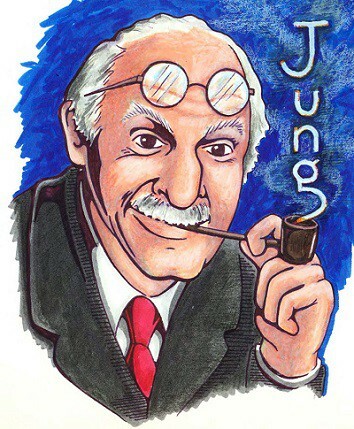The 8 personality types according to Carl Gustav Jung
Have you heard of the eight types of personalities that he proposed Carl Gustav Jung?
It is no secret that one of the main endeavors of psychologists, historically, has been to describe Personality traits. In some cases this has been due to the need to create more or less objective parameters with which create personality profiles useful for the selection of personnel, the description of client typologies or research in mental disorders and risk factors.
In other cases, it could be explained by motivations less related to the pragmatic. At the end of the day, simply putting some order into the chaos of behaviors that humans can exhibit can, in itself, be satisfying. That is why several psychometric test (such as the 16 PF of Raymond Cattell) that have offered the possibility of measuring aspects of personality and intelligence in a systematic way.
Carl Jung, however, was not interested in these types of classifications because he considered them too rigid. This follower of the psychodynamic paradigm initiated by Sigmund Freud she preferred to wage war on his side.
The eight personality profiles, according to Jung

At the beginning of the 20th century, when psychology was entering its adolescence, one of the most important representatives of the psychodynamic current he set himself the task of describing the personality types that define us from a mystical perspective, fundamentally esoteric, and probably without taking into account the possible practical applications of his proposals.
His name was Carl Gustav JungAnd even if you haven't heard of him, it's quite possible that you've ever used two of the terms that were popularized by him: introversion and extraversion.
Carl Jung and his approach to personality types
The relationship between Carl Jung, philosophy and psychology (understood as the exploration of what spiritual and non-material) dates back to the first years of his life and lasted until his death, in 1961. During this time he tried to describe the logics that make the human psyche work. and the way in which it relates to the spiritual world, using concepts such as the collective unconscious or the archetypes. Not in vain is Carl Jung remembered as the founder of deep psychology (or analytical psychology), a new "school" distanced from the freudian psychoanalysis in which Jung came to participate during his youth.
Carl Jung did not want to describe physical mechanisms that allow us to predict to a lesser or greater extent how we behave. He wanted to develop tools that would allow us to interpret the way in which, according to his beliefs, the spiritual is expressed through our actions.
That is why, when the moment of his career came when he set out to investigate the types of personality, Carl Jung did so without giving up his particular view of the immaterial nature of mind. That led him to use the concepts of introversion and extraversion, which despite being very abstract have generated a lot of interest.
The introverted and the extroverted personality
Usually Introversion has been linked to shyness and extraversion to openness to meeting people. Thus, introverts would be reluctant to enter into a conversation with someone unknown, they would prefer not to attract too much attention and they would be easy prey for nerves in situations where they must improvise in front of a lot of people, whereas extroverts would tend to prefer situations socially stimulants.
However, Carl Jung did not define the introverted and extroverted personality by focusing on the social. For him, what defined the introversion-extraversion dimension of personality were the attitudes towards the phenomena subjective (fruits of the imagination and one's own thought) and objects external to oneself (what happens to our around).
Introverts, according to Carl Jung, are those who prefer to "withdraw into themselves" and focus their attention and efforts to explore their own mental life, whether it be fantasizing, creating fictions, reflecting on abstract themes, etc. The extraverted personality, on the other hand, is characterized by showing greater interest in what is happening at every moment outside, the real world not imagined.
Thus, introverts would have a tendency to prefer to be alone than in the company of strangers, but exactly because of their shyness (understood as a certain insecurity and a high concern for what others think of oneself), but as a consequence of what makes them people introverts: the need to be interested in these people, maintain a certain degree of alertness for what they can do, look for topics of conversation, etc. Extraverted people, on the other hand, would feel more stimulated by what happens around them, regardless of whether it has to do with complex social situations or not.
The four basic psychological functions
In Carl Jung's personality types, the introversion-extraversion dimension is mixed with what he considered the four psychological functions that define us: think, feel, perceive and intuit. The first two, thinking and feeling, were for Jung rational functions, while perceiving and intuiting were irrational.
From the combination of each of these four functions with the two elements of the introversion-extraversion dimension, Carl Jung's eight personality types emerge.
The psychological types
Carl Jung's Personality Types, published in his 1921 work Psychological Types, are the following.
1. Introvert-thinking
People belonging to the category reflective-introvertare much more focused on their own thoughts than on what happens beyond them. They are specifically interested in abstract thoughts, reflections and theoretical battles between different philosophies and ways of seeing life.
Thus, for Jung this type of personality is the one that in popular culture we could relate to the tendency to philosophize, the concern for the relationships between ideas.
2. Sentimental-introvert
People belonging to the personality type feeling-introvertthey are not very talkative, but nice, empathetic and without special difficulties to create affective bonds with a small circle of people. They tend not to show their attachment, among other things due to the lack of spontaneity when expressing how they feel.
3. Feeling-introvert
As in the rest of the personalities defined by introversion, the personality sensitive-introvert is characterized by being focused on subjective phenomena. In this case, however, these phenomena are more related to stimuli received through the senses than to feelings or abstract ideas. As defined by Carl Jung, this personality type often describes people who are engaged in art or crafts.
4. Intuitive-introvert
In this type of personality intuitive-introverted, what focuses the interest of the person are fantasies about the future and what's to come... at the cost of paying attention to the present. These people would be of a rather dreamy character, showing detachment from immediate reality and prefer to give space to imagination.
5. Extraverted-thinking
This personality type reflective-extroverted is defined by the tendency to create explanations about everything from what the individual sees around him. This means that these rules are understood as immovable principles on how objective reality is structured, for which this type of people would have a very characteristic way of seeing things and that changes very little with the weather. In addition, according to Carl Jung, they try to impose this vision of the world on other people.
6. Sentimental-extrovert
This category sentimental-extroverted would be composed of highly empathetic people, with ease to connect with others and who enjoy company a lot. According to Jung, this personality type is defined by the fact that it is related to very good social skills and a low propensity for reflection and abstract thinking.
7. Extraverted-feeling
In this type of personality sensitive-extroverted the search for new sensations with experimentation with the environment and with others. The people described by this type of personality are very given to the search for pleasure in interaction with real people and environments. These individuals are described as very open to experiences they have never had. before, in such a way that they show an opposite disposition to those who oppose what is not family.
8. Intuition-extraversion
Carl Jung's latest personality type, the guy intuitive-extroverted, it is characterized by the tendency to undertake all kinds of projects and adventures of medium or long duration, so that when one phase ends, you want to start another immediately. Travel, business creation, transformation plans... the future perspectives related to the interaction with the environment are the center of the concerns of these people, and they try to make that the rest of the members of their community help them in their endeavors (regardless of whether others benefit as much as oneself or not).
Are Jung's Personality Types Helpful?
The way in which Carl Jung created these personality types is far from what is attempted today, based on statistical analysis and research involving hundreds of people. Not even in the first half of the 20th century were there the methods and tools to create models of personality with any robustness, nor did Jung's thinking ever fit in with the mode of inquiry still in the scientific psychology, very concerned with creating objective criteria to delimit personality traits and test theories starting by contrasting expectations with reality.
Out of Carl Jung's eight personality types, the Myers-Briggs Indicator has emerged, and the concepts of introversion and extraversion have greatly influenced important psychologists of individual differences, but in themselves these descriptions are too abstract to predict typical behavior of individual differences. people. Sticking to these kinds of definitions about personality can make us easily fall into the forer effect.
However, that Carl Jung's proposal has almost non-existent scientific value does not mean that it cannot be used as a philosophical reference, a way of seeing ourselves and others that is suggestive or poetic. Of course, its objective value is not greater than that of any other classification of types of personalities that a person not trained in psychology or psychometry can perform.
Bibliographic references:
- Clay, C. (2018). Mazes: Emma, her marriage to Carl Jung, and the early years of psychoanalysis. Madrid: Three Points Editions.
- Frey-Rohn, L. (1991, 2006). From Freud to Jung. Mexico: Economic Culture Fund.



